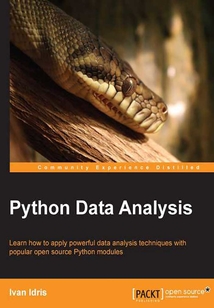舉報 

會員
Python Data Analysis
最新章節:
Index
Thisbookisforprogrammers,scientists,andengineerswhohaveknowledgeofthePythonlanguageandknowthebasicsofdatascience.ItisforthosewhowishtolearndifferentdataanalysismethodsusingPythonanditslibraries.Thisbookcontainsallthebasicingredientsyouneedtobecomeanexpertdataanalyst.
目錄(161章)
倒序
- 封面
- 版權頁
- Credits
- About the Author
- About the Reviewers
- www.PacktPub.com
- Support files eBooks discount offers and more
- Preface
- What this book covers
- What you need for this book
- Who this book is for
- Conventions
- Reader feedback
- Customer support
- Chapter 1. Getting Started with Python Libraries
- Software used in this book
- Building NumPy SciPy matplotlib and IPython from source
- Installing with setuptools
- NumPy arrays
- A simple application
- Using IPython as a shell
- Reading manual pages
- IPython notebooks
- Where to find help and references
- Summary
- Chapter 2. NumPy Arrays
- The NumPy array object
- Creating a multidimensional array
- Selecting NumPy array elements
- NumPy numerical types
- One-dimensional slicing and indexing
- Manipulating array shapes
- Creating array views and copies
- Fancy indexing
- Indexing with a list of locations
- Indexing NumPy arrays with Booleans
- Broadcasting NumPy arrays
- Summary
- Chapter 3. Statistics and Linear Algebra
- NumPy and SciPy modules
- Basic descriptive statistics with NumPy
- Linear algebra with NumPy
- Finding eigenvalues and eigenvectors with NumPy
- NumPy random numbers
- Creating a NumPy-masked array
- Summary
- Chapter 4. pandas Primer
- Installing and exploring pandas
- pandas DataFrames
- pandas Series
- Querying data in pandas
- Statistics with pandas DataFrames
- Data aggregation with pandas DataFrames
- Concatenating and appending DataFrames
- Joining DataFrames
- Handling missing values
- Dealing with dates
- Pivot tables
- Remote data access
- Summary
- Chapter 5. Retrieving Processing and Storing Data
- Writing CSV files with NumPy and pandas
- Comparing the NumPy .npy binary format and pickling pandas DataFrames
- Storing data with PyTables
- Reading and writing pandas DataFrames to HDF5 stores
- Reading and writing to Excel with pandas
- Using REST web services and JSON
- Reading and writing JSON with pandas
- Parsing RSS and Atom feeds
- Parsing HTML with Beautiful Soup
- Summary
- Chapter 6. Data Visualization
- matplotlib subpackages
- Basic matplotlib plots
- Logarithmic plots
- Scatter plots
- Legends and annotations
- Three-dimensional plots
- Plotting in pandas
- Lag plots
- Autocorrelation plots
- Plot.ly
- Summary
- Chapter 7. Signal Processing and Time Series
- statsmodels subpackages
- Moving averages
- Window functions
- Defining cointegration
- Autocorrelation
- Autoregressive models
- ARMA models
- Generating periodic signals
- Fourier analysis
- Spectral analysis
- Filtering
- Summary
- Chapter 8. Working with Databases
- Lightweight access with sqlite3
- Accessing databases from pandas
- SQLAlchemy
- Pony ORM
- Dataset – databases for lazy people
- PyMongo and MongoDB
- Storing data in Redis
- Apache Cassandra
- Summary
- Chapter 9. Analyzing Textual Data and Social Media
- Installing NLTK
- Filtering out stopwords names and numbers
- The bag-of-words model
- Analyzing word frequencies
- Naive Bayes classification
- Sentiment analysis
- Creating word clouds
- Social network analysis
- Summary
- Chapter 10. Predictive Analytics and Machine Learning
- A tour of scikit-learn
- Preprocessing
- Classification with logistic regression
- Classification with support vector machines
- Regression with ElasticNetCV
- Support vector regression
- Clustering with affinity propagation
- Mean Shift
- Genetic algorithms
- Neural networks
- Decision trees
- Summary
- Chapter 11. Environments Outside the Python Ecosystem and Cloud Computing
- Exchanging information with MATLAB/Octave
- Installing rpy2
- Interfacing with R
- Sending NumPy arrays to Java
- Integrating SWIG and NumPy
- Integrating Boost and Python
- Using Fortran code through f2py
- Setting up Google App Engine
- Running programs on PythonAnywhere
- Working with Wakari
- Summary
- Chapter 12. Performance Tuning Profiling and Concurrency
- Profiling the code
- Installing Cython
- Calling C code
- Creating a process pool with multiprocessing
- Speeding up embarrassingly parallel for loops with Joblib
- Comparing Bottleneck to NumPy functions
- Performing MapReduce with Jug
- Installing MPI for Python
- IPython Parallel
- Summary
- Appendix A. Key Concepts
- Appendix B. Useful Functions
- matplotlib
- NumPy
- pandas
- Scikit-learn
- SciPy
- Appendix C. Online Resources
- Index 更新時間:2021-08-05 17:32:19
推薦閱讀
- 人工免疫算法改進及其應用
- Dreamweaver 8中文版商業案例精粹
- Creo Parametric 1.0中文版從入門到精通
- 數據庫原理與應用技術
- Deep Reinforcement Learning Hands-On
- Microsoft System Center Confi guration Manager
- 計算智能算法及其生產調度應用
- PowerPoint 2010幻燈片制作高手速成
- 數字多媒體技術與應用實例
- Flash CS5二維動畫設計與制作
- 大數據時代的調查師
- 歐姆龍PLC應用系統設計實例精解
- 大話數據科學:大數據與機器學習實戰(基于R語言)
- Arduino創意機器人入門:基于ArduBlock(第2版)
- 白話機器學習算法
- 數據庫技術及應用
- 局域網組建與管理技術詳解
- 智能與智慧:人工智能遇見中國哲學家
- 網絡互聯組網配置技術
- 仿魚機器人的設計與制作
- 軸向磁場無刷同步電機理論與設計
- RIA開發權威指南
- 一站式學習C編程
- 深度學習:語音識別技術實踐
- Flink基礎教程
- 數據庫應用技術:Visual FoxPro 6.0
- PowerShell Core for Linux Administrators Cookbook
- 數據庫系統管理實務
- 深度學習實戰
- 計算機實用技能及應用

